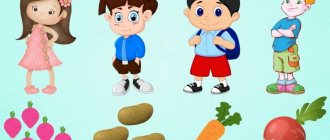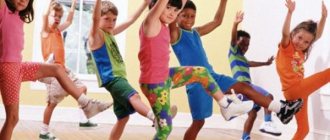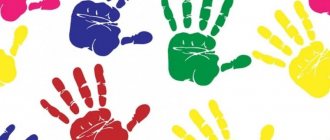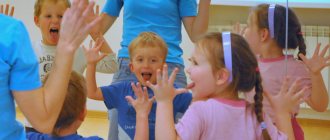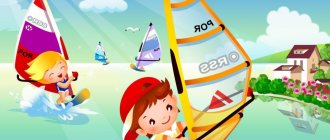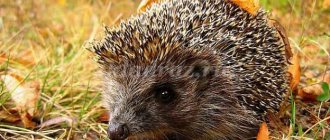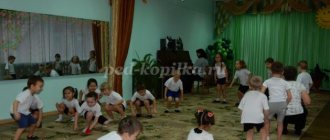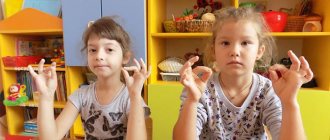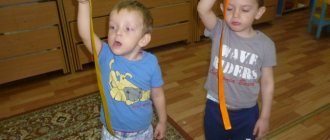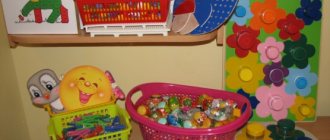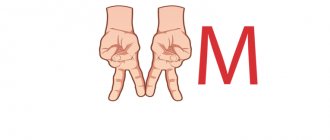Finger games for children give parents and educators the opportunity to play with their children, make them happy and, at the same time, develop speech and fine motor skills.
Performing exercises and rhythmic movements with the fingers leads to excitation in the speech centers of the brain and a sharp increase in the coordinated activity of speech zones, which ultimately stimulates the development of speech.
An adult should pronounce the texts of finger games as expressively : either raising or lowering his voice, making pauses, emphasizing individual words, and perform movements synchronously with the text or during pauses. Finger games with singing attract the greatest attention of the child. You can sing the proposed texts to any suitable melody.
It is difficult for kids to pronounce the text; it is enough for them to perform the movements together with an adult or with his help.
Finger games are the staging of any rhymed stories, fairy tales, or poems using the fingers. They are exciting and promote the development of speech and creative imagination.
Children who repeat the movements of adults develop the ability to control their movements and concentrate attention on one type of activity.
When performing each exercise, you should try to involve all your fingers; perform the exercises with both your right and left hands. Finger games provide an opportunity to play with kids, delight them and, at the same time, develop speech and fine motor skills.
Thanks to such games, the child receives a variety of sensory impressions, he develops attentiveness and the ability to concentrate.
Fun to prevent your child's health
The Japanese doctor Namikoshi Tokujiro pointed out in his writings the presence of a large number of receptors in the fingers connected to the central nervous system, due to which the brain receives various impulses from the muscles. The motility of motor muscle activity contributes to the formation of the human psyche and intelligence. Finger gymnastics for kids is one of the forms of such development. This method helps stimulate brain activity, activating certain areas of the hemispheres responsible for hearing, speech, movement and psyche. The famous teacher V.A. Sukhomlinsky once said that a child’s mind is at his fingertips.
Okay - okay
We all know very well the children's finger gymnastics "Magpie - Crow", in which the mother, gently saying, carries out various manipulations with the palms of her baby, influencing their nerve receptors. Circular movements of the finger in the center of the palm stimulate the child's digestive organs. This motor training can confidently be classified as “finger gymnastics”, which actively develops the fine motor skills of a toddler’s hands. As a result, the little man's fingers become more flexible and agile. And besides this, speech improves, attention sharpens, reaction speed and creative abilities develop.
Exercises with a ball
Exercises with a ball are an effective way to relax and relieve tension in children's palms. This rubber toy with rounded spikes stimulates the child's psychomotor environment and engages his deep muscular constitution. Soft spikes are used to massage the head, feet and palms, increasing blood circulation and improving the functioning of the little person's nervous system. Finger gymnastics for children necessarily includes classes of this type. It is recommended that the baby periodically roll round objects in his palms.
How to develop a child's memory
Today, acupressure massage of the baby’s fingers and feet is very widely used. To prevent all sorts of functional disorders in the child’s body caused by insufficient mobility, leading to stagnation of blood circulation, it is necessary to give the child a preventive massage. The massage therapist influences reflex points, which, in turn, activate the brain. Finger gymnastics fulfills the same mission, but also develops excellent memory. Enter into a playful dialogue with your baby, show him the movements, clearly explaining why you are doing this, and he will undoubtedly be happy to repeat them after you.
We rub our palms (three palms actively between each other),
We clap like a cat's eyes (we clap them rhythmically),
We rub our finger (we rub our thumb with force, because at its base there are points that stimulate brain function),
We play catch-up (we collect one hand into a fist, straighten the other, do it in turn),
Nevermind, and okay! (We show the figurine with one hand, raise the thumb of the other hand up; change one by one.)
Choose us quickly! (We change the index and middle fingers on our hands opposite each other).
Hello, hello, smack and smack (we put our palms together and cross our fingers),
The lesson has come to an end (press your palms together in different directions).
Now, until redness appears, we actively rub the ears, because there are points that stimulate brain development:
We rub our ears together,
We need to hear well.
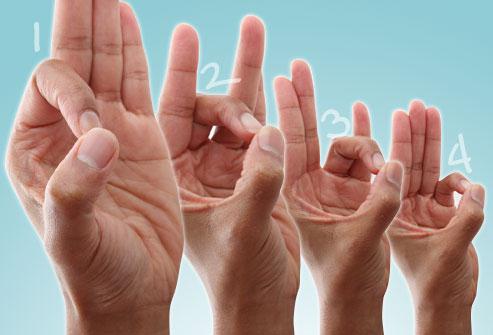
Finger gymnastics for children 5 years and older
House
I want to build a house, (Fold my hands like a house and raise it above my head) So that there is a window in it, (Join the fingers of both hands in a circle) So that the house has a door, (We connect the palms of our hands together vertically) So that a pine tree grows nearby. (We raise one hand up and “spread” our fingers) So that there is a fence around, The Dog guards the gate, (We join our hands in a lock and make a circle in front of us) The sun was out, it was raining, (First we raise our hands up, our fingers are “spread”. Then the fingers lower it down, make “shaking” movements) And the tulip bloomed in the garden! (Put your palms together and slowly open your fingers - “tulip bud”)
Ship
A boat is floating along the river, (We press the lower parts of our palms together, the upper ones are open - we show the “boat”) It floats from afar, (We place our left hand horizontally to our eyes - “we look into the distance”) There are four very brave sailors on the boat. (Show 4 fingers) They have ears on the top of their heads, (We put both palms to our ears) They have long tails, (We connect the fingertips of both hands together and then slowly spread our arms to the sides) And only cats are scary to them, only cats and cats! (We show two open palms, then bend the fingers slightly - we get “claws”) At the end of this game, you can ask the child: - What kind of sailors were on the boat? (Answer: mice)
How many birds?
How many birds flew to our feeder? (they rhythmically clench and unclench their fists) We will tell you: (for each name the birds bend one finger) Two tits, a sparrow, Six goldfinches and pigeons, A woodpecker in motley feathers. Everyone had enough grains (they clench and unclench their fists again).
"Ear-nose"
With your left hand, grab the tip of your nose, and with your right hand, grab the opposite ear. Let go, clap your hands and reverse the position of your hands.
The “Ear-nose” exercise is extremely useful for primary schoolchildren and adults. It “forces” both hemispheres to work, which has a beneficial effect on the child’s academic performance. Once you learn how to do it slowly, you can move on to speeding it up. It's fun!
Hares
Ten gray hares Dozed under a bush, (Hands lay freely on the table) And two suddenly said: “There’s a man with a gun” (Raise the thumbs of both hands up) Two shouted: “Let’s run away!”, (Raise the index fingers of both hands up) Two whispered, “Let’s be silent!”, (Raise the middle fingers of both hands up) Two suggested: “We’ll hide in the bushes!” (Raise the ring fingers of both hands up) And two suddenly asked: “Can he do “Bang”?” (Raise the little fingers of both hands up) “Bang” - the hunter shot, (Clap his hands) Pressing the trigger of the gun, And ten gray hares Set off ran away. (We run all our fingers across the table.)
Learning to hold a pencil
From early childhood, kids draw various scribbles and curved lines in the album, but they do it completely haphazardly, not knowing how to direct their hand to the right place. This prerequisite is nothing more than a psychophysiological need for self-expression through the ability to write and draw. The child confidently clutches a pencil in his fist and begins to draw with it in a sweeping manner across the sheet of paper in a chaotic disorder. Finger gymnastics will help show and explain to a toddler in a more accessible and understandable language how to hold a pencil in his hand correctly. 3-4 years is the age when children want to quickly write down, draw, and color something. But for a reason - they want to do it like adults. But to do this, you must first find out how to handle a pencil, but perseverance and attention are not enough. Let's try to figure out this issue using a game form.
The teacher hands out a colored pencil to all the children. Holding her pencil in her hand, she speaks on his behalf:
I greet you, my young colleagues! It's me - Cheerful Pencil! I know that you love to draw, and you are great at it! However, many of you are holding me incorrectly, and therefore my sides hurt, my neck aches, and my body has become very heavy. I asked my brothers to help teach you how to use me correctly.
So, we took the pencil in our left hand. They placed it on the middle finger of the right hand, pressed it on top with the index finger, and supported it below with the thumb. See how simple it is! Now try to draw a line like this! Well done!
This game will help children understand how to use a pencil correctly.
Adults are required to pay special attention to the development of the little man's arms, hands and fingers so that he can learn to hold a pen, pencil and brush, and in the future - to draw and write. But how to concentrate children's attention? And again finger gymnastics comes to the rescue, which is an excellent training for developing the physical and mental skills of the baby. To prevent your child from getting tired, divide the 20-minute lesson into 4 parts and play similar games approximately every 5 minutes.
Example:
We drew and wrote
Fingers are completely tired (work rhythmically and clearly with your fists),
Jump your fingers (fingers “jump” on the table),
Like little white bunnies (raise the index and middle fingers to the top, like ears, and straighten the rest).
Jump and jump, jump and jump,
They jumped onto the meadow (their fingers “jumped” on the table).
The wind shakes the grass,
Develops left and right (light movements of arms and hands from right to left).
Bunnies are not afraid of the wind (Wave your palms horizontally in front of you),
Having fun on the lawn (Clap their hands together).
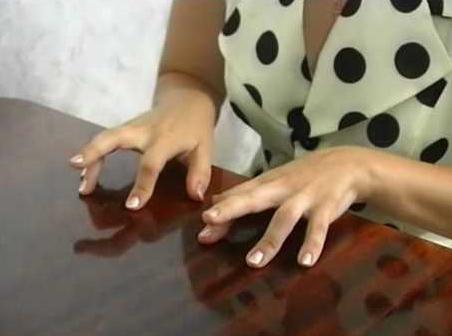
Finger gymnastics for preschoolers involves a more serious approach in preparing for school. To do this, you need to purchase a notebook with a large square, in which the child will learn to draw sticks, draw circles and squares, and write the first letters in his life. Such classes actively develop the accuracy of hand movement, remove stiffness and tension in the hand. The child must be taught to write or draw without breaking the line, without lifting the pen or pencil from the paper. During breaks between lessons or after certain activities, you can play a game aimed at developing fine motor skills. The kids will really like it and will help them relax.
Draw a big line...
Place the thumb and middle finger together, move the thumb far to the side and move the middle finger towards it. And we do this 2 times.
Let's draw another line...
Repeat the same movements in the other direction.
And we draw circles,
Different, like little bells.
Use both pens and each finger to draw circles separately on the table.
And then let's go for a walk...
Use your thumb and index finger to depict a gait.
Let's find different letters.
Click separately on each letter in the alphabet.
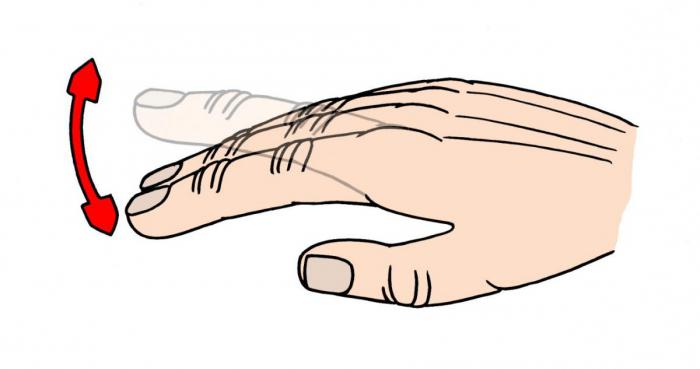
Card index: finger games for children
Finger games encourage children to be creative, and in the case when a child comes up with his own, even if not very successful, movements for texts, he should be praised and, if possible, show his creative achievements, for example, to dad or grandmother.
From here you can print out a finger theater for children.
Pointer
My mouth can eat, (we point the baby’s finger at his lips) My nose can breathe, and my ears can listen. (point to the nose, ear) Little eyes can blink, (blink) Hands - grab everything, grab everything. (clench your palms into fists several times)
Thumb Boy
We touch the child’s fingers one at a time for each line, lightly shaking the nail phalanges. Let's start with the little finger:
- Little Thumb, where have you been? - I went to the forest with this brother, I cooked cabbage soup with this brother, I ate porridge with this brother, I sang songs with this brother.
Toys
I play with toys: (Hands in front of me, clench and unclench the fingers of both hands.) I throw you a ball, (We stretch our arms forward - “throw the ball.”) I assemble a pyramid, (We place straight hands, palms down, on top of each other several times. ) I drive the truck everywhere. (Move your right hand slightly open in front of you – roll the car.”)
Cam
As soon as I clench my fist (we clench our hand into a fist), I’ll put it on its side! (put up a fist with your thumb sticking out) I’ll open my palm, (straighten my hand) I’ll put it on my leg. (the hand is placed on the knee, palm down)
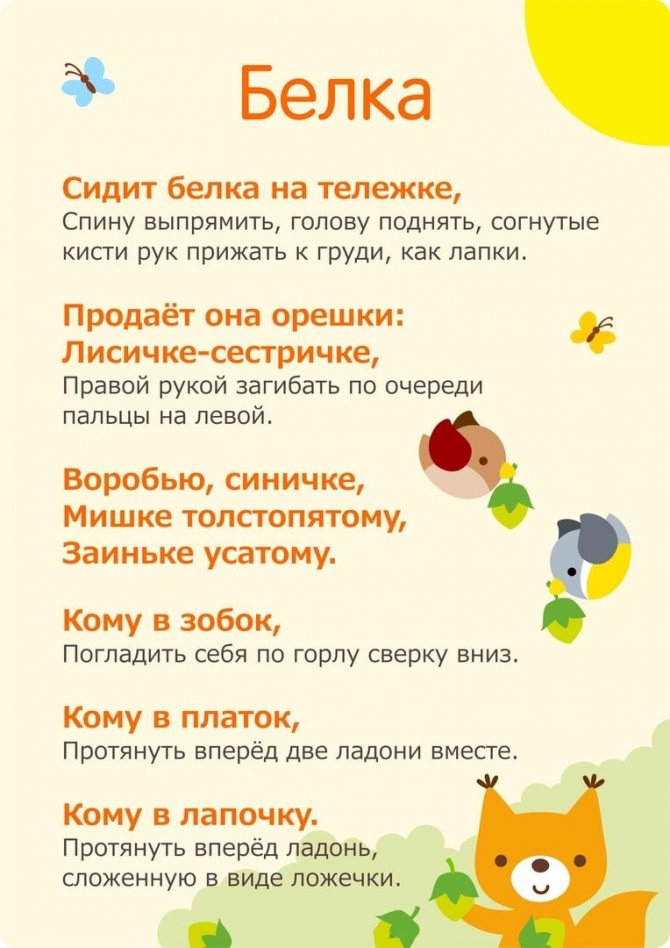
Owl-owl
The child’s hands hug his face and smoothly turn his head left and right:
Little owl, big head, sits on a branch, looks in all directions, and suddenly he flies! (arms to the sides and wave them like wings)
Ball
My funny round ball, (We hit an imaginary ball with one hand.) Don’t hide your round cheeks! (Change hands.) I’ll catch you, (With both hands, joining the fingers of the same name, we show the ball.) I’ll roll you in my hands! (Roll an imaginary ball between your palms.)
Ooty-ooti
Ooty-ooh, they flew, (we take the baby’s hands in ours and wave his arms) They sat on the little head, (we put the child’s palms on his head. They pecked, pecked, (“pecking” the child’s head with his fingers) And they flew home. (we remove our hands from the head and spread apart)
Before bedtime
Before going to bed, we take the child’s hand, stroke it and bend each finger and read a poem: This finger wants to sleep, (Bend the index finger) This finger went to bed, (Bend the middle finger) This finger has already taken a nap, (Bend the ring finger) This finger has already fallen asleep . (We bend the little finger) This one is sleeping soundly, soundly, (We bend the thumb) And he tells you to sleep. (we take the child’s fist in our hand, stroke his head and wish him good night, kissing him).
Geese-geese
- Geese, geese! (fingers are collected, as if we are imitating a beak, rotating the beak hand around its axis) - Ha-ha-ha! (the thumb lowers and rises relative to the rest - as if we are clicking our beak) - Do you want to eat? (fingers are collected, as if we are imitating a beak, rotating the beak hand around its axis) - Yes, yes, yes! (the thumb lowers and rises relative to the rest - as if we are clicking our beak)
Berries
I pick berries from the branch (Fingers are relaxed, hanging down. With the fingers of the other hand, stroke each finger from the base to the very tip, as if removing an imaginary berry from it.) And I collect it in a basket. (Cup both palms in front of you.) There will be a full basket. (Cover one cupped palm with the other cupped palm.) I’ll try a little. (One folded palm imitates a basket, with the other hand) I’ll eat a little more, (Take out imaginary berries and put them in your mouth.) The path to home will be easy! (Imitating legs, the middle and index fingers on both hands “run away” as far as possible.)
Mouse
The mouse sat on the butter dish (the palm of his right hand covers his left fist) And the butter dish is a sticky mushroom. (rotate with the left fist, covered with the right palm) The mouse sat on it (slide the right palm on the fist) And stuck, stuck, stuck. (“we tear off” the palm from the fist, and it clasps the fist and holds on)
Woodpecker
A woodpecker chimes into a tree: Knock-knock-knock. (the left palm is straight - a tree, the fingers of the right hand are gathered together, imitating the beak of a woodpecker. The right palm, gathered into a “beak”, knocks on the left) All day long in the forest there is Knock-knock-knock. (everything is the same, but we change the roles of hands)
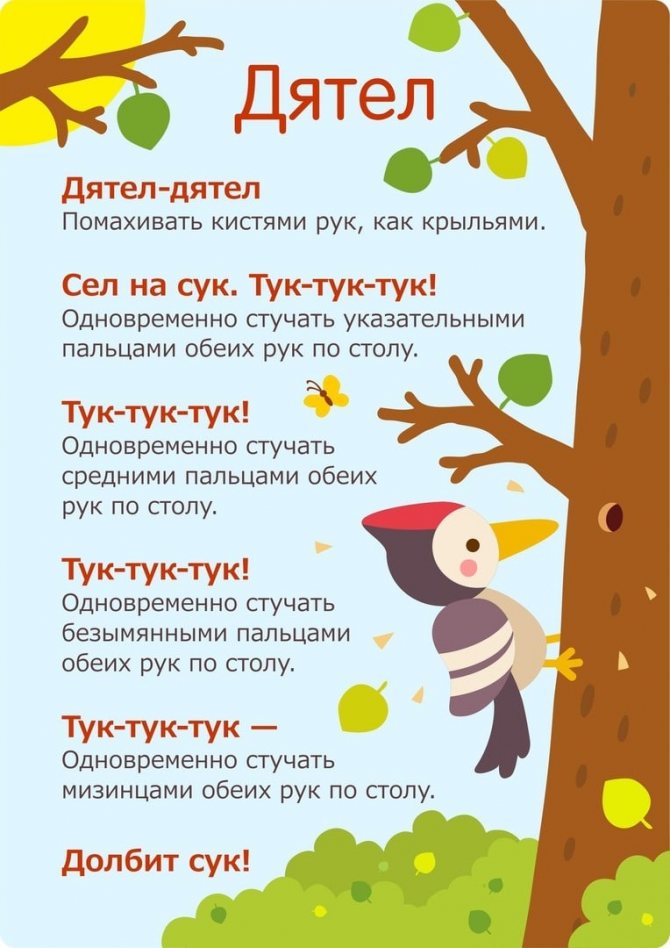
Rams
Once two sheep butted heads (hands in fists, fists butting each other) On the bridge early in the morning. (clap for every word) They didn’t want to give in - (fists butt again) Together they flew into the river. (we hit our knees with our palms)
Magpie Crow
The magpie-crow was cooking porridge, (we take the child’s palm in our hands and move our finger clockwise across the palm, as if we are stirring porridge). She cooked the porridge and fed the children. I gave it to this one, (we bend the child’s little finger) I gave it to this one, (we bend the ring finger) I gave it to this one, (we bend the middle finger) I gave it to this one, (we bend the index finger) But I didn’t give it to this one: (we move the thumb) You didn’t carry wood, you didn’t light the stove , We won’t give you porridge! (you can tickle the child lightly)
Play magpie-crow with both hands.
Snail
The thumb of the right hand holds the bent middle and ring fingers. The index and little fingers remain straight - we imitate a snail:
The snail pokes with its horns - The gate in the garden is locked. (“the snail” rests and pokes into the open left palm-gate) Open the gate quickly, (we turn the palm-gate like a door so that the snail does not have an obstacle) Let the snail home. (“snail” slides along the open palm gate)
Repeat the game, changing hands.
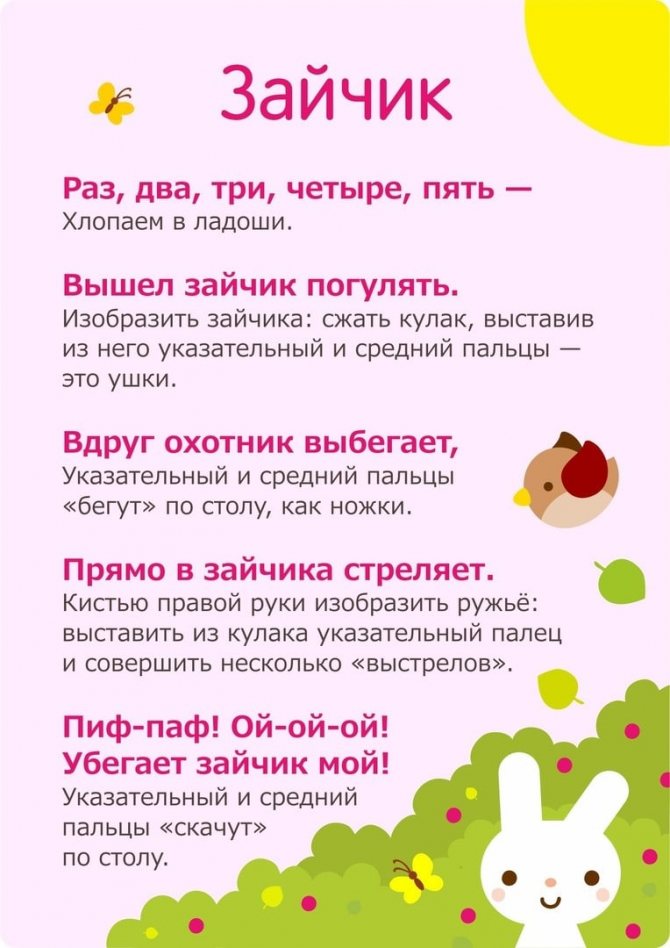
About grandma
“Once upon a time there was a grandmother, (hands on hips) Yes, she lived by the river. (we spread our arms to the sides, palms down - we depict a river) The grandmother wanted (hands on her hips again) to swim in the river. (depict breaststroke swimming) And the grandmother (hands on hips) bought soap and washcloth.” (we stretch out one hand, and the second one seems to be lathering it with soap) This fairy tale is good, (we make fists with thumbs up) I’ll start from the beginning: “Once upon a time there was a grandmother...”
Magpie white-sided
You, white-sided magpie, (we wave our arms like wings) Teach me to fly. (raise our hands up) Neither high nor far - (handles to the sides) You can only see the sea. (palm with visor facing forehead)
Knock Knock
- Knock-Knock! (hands into fists, 3 fist strikes against each other) - Yes, yes, yes! (3 clapping hands) - Can I come to you? (3 fist bumps against each other) - Always happy! (3 clapping hands)
Borovichok
There is a toast in the clearing. (right hand clenched into a fist) This is a boletus mushroom. (cover the fist with our left palm) And under it, having collected their belongings, snails are hiding in the rain. (the left hand remains on top, and the right hand below it imitates a snail: the thumb of the right hand holds the bent middle and ring fingers, and the index and little fingers remain straight).
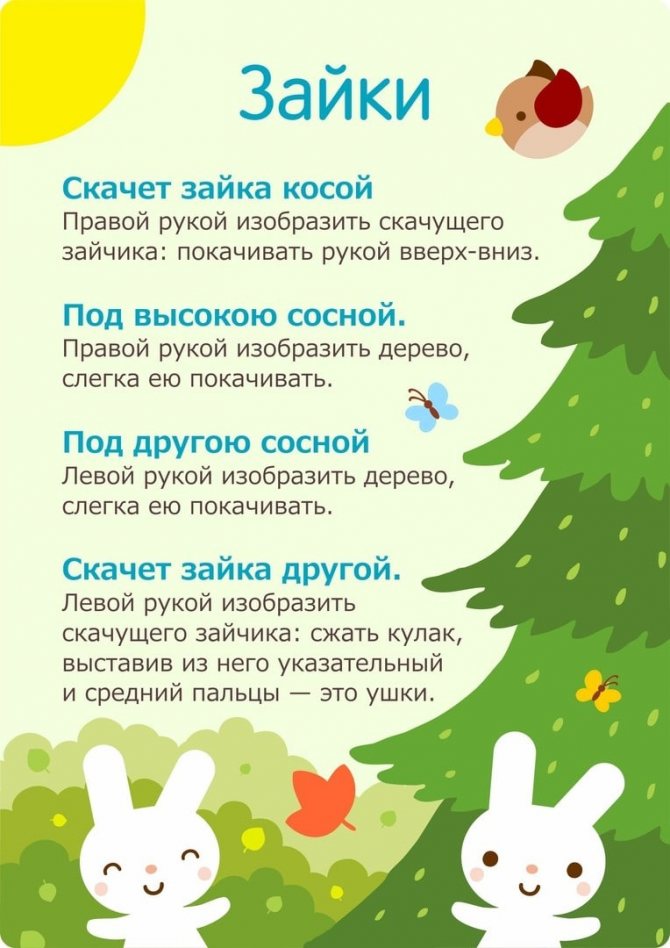
Kulichiki
We make Easter cakes (palms are placed crosswise with either the right or left hand on top) Round, like faces. (the child runs his hands over his cheeks from top to bottom) Take it out of the oven (we open our hands one by one, palms up) Delicious Easter cakes. (the adult places his hand in a slide, first on one palm of the child, then on the other - hands out Easter cakes)
Two kids
On both hands we press the middle and ring fingers with our thumbs - we make a “goat”. The mother recites a poem and, together with the baby, points her hands with “horns” towards each other. Fingers butt against each other. Do this several times. At the word “bang” we clap our hands, at the word “plop” we lower our hands to our knees.
Once upon a time, a little goat was walking across the bridge to visit someone. And another one was walking towards him, he was returning home. Two horned stupid brothers began to butt heads on the bridge, not wanting to give in and let the other one through. The goats fought for a long time, scattering and jostling. With a running head-on - bang! And from the bridge into the water - splash!
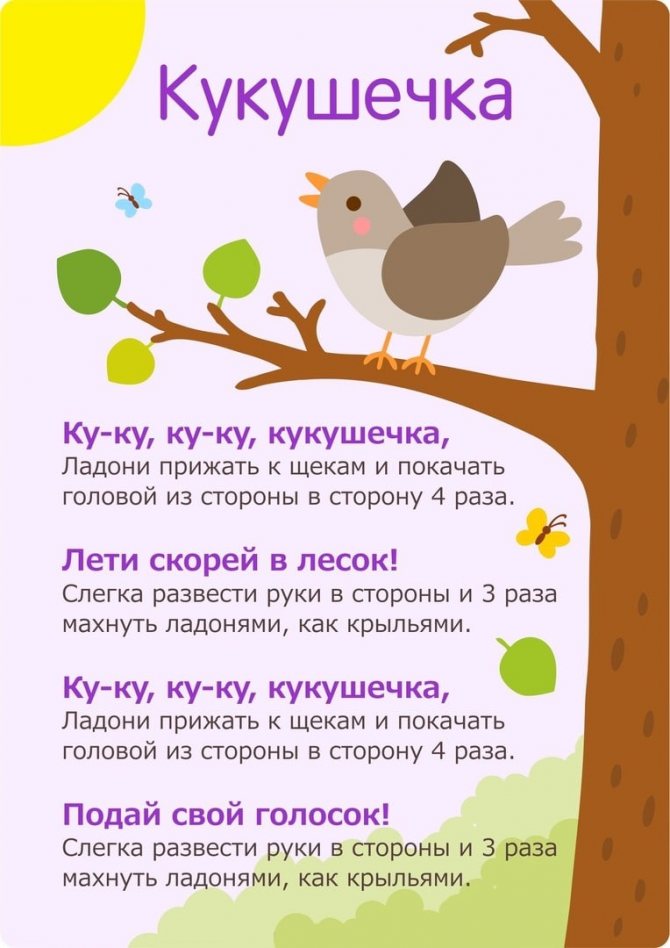
Fingers
Gently knead the child's fingertips (nail phalanges). The adult's thumb is placed on the child's nail, the child's pad is moved between the adult's thumb and index finger. Let's start with the little finger.
(child's name) and I play, (5th finger, little finger) We go through all the fingers: (4th) This finger is the longest, (3rd) This finger is smarter than everyone, (2nd) This finger is shorter than everyone else, (1st, thumb) This one wants to become bigger, (1st) This one knows all the toys, (2nd) This one has ears on top of his head, (3rd) This one hides in the shadows, (4th j) This one is a little son. (5th)
The element of imitation is an important aspect in a child’s life
One of the important ways of teaching and developing a child in preschool age is the element of imitation. Finger gymnastics in kindergarten helps to reveal the acting abilities of children with the help of puppet shows. Putting rag dolls on their fingers, children are immersed in a magical theatrical world in which fairy-tale characters come to life and speak their language. It is game situations of this type that stimulate the attention and memory of the little artist.
You can theatricalize any fairy tale, say, “Ryaba the Hen.” All movements, one after another, must be accompanied by words and rhythmic clapping. While performing these exercises, you need to actively involve all your fingers in turn in the gaming activity. A well-constructed activity will bring great joy to the child, and he will be happy to wait for the next invented story. This type of activity is also finger gymnastics. Whether the child is 3 or 5 years old does not matter, in this case there is no need to set age limits, the main thing is that the children really like such games.
Example (jump on your palm with two fingers):
A little hare was jumping across the field -
Bully, naughty girl.
Use your little finger to make circular movements on your palm:
The little fox-sister came running,
She wagged her tail and ran off into the forest.
The ring, middle and index fingers take turns tapping the palm:
The rain was knocking on the window,
Drip-drip-drip-drip.
Scratch the back of your hand:
And the kitten claws
Scratch-scratch, scratch-scratch.

Finger gymnastics for children 3-4 years old
Developmental activities include not only mother’s lessons, but also visits to thematic classes in schools and kindergartens. During such classes, finger gymnastics in kindergarten will also become an indispensable component.
Bunny
The bunny was jumping through the forest, (his fingers “jumping” on the table) The bunny was looking for food for himself. (we move the fingers of both hands one by one on the table) Suddenly, on the top of the bunny’s head, the ears rose up like arrows. (we depict ears with our hands) A quiet rustling is heard: Someone is sneaking through the forest. (fingers slowly walk along the table) The hare confuses his tracks, runs away from trouble. (fingers quickly and quickly run in circles on the table)
Orange
We shared an orange! (hands clasped together, we shake) There are many of us, (we spread our fingers) And he is alone. (show only one finger) This slice is for a hedgehog, (fingers folded into a fist, bend one finger at a time) This slice is for a swift, (bend the next finger) This is a slice for ducklings, (bend the next finger) This is a slice for kittens, (bend the next finger finger) This slice is for the beaver, (bend the next finger) And the peel is for the wolf! (palms down, fingers spread) He's angry with us, it's a disaster! (wag a finger) Run away in all directions! (imitate running your fingers on the table)
Be sure to show your baby a cartoon with your favorite rhyme “Orange”.
For a walk
The fingers went for a walk (the fingers are clenched into fists, the thumbs are lowered down and move as if in jumps on the table) And the second fingers went to catch up (rhythmic movements of the index fingers on the table) The third fingers ran (movements of the middle fingers at a fast pace) And the fourth fingers walked (slow movements ring fingers on the table) The fifth finger jumped (rhythmically touching the surface of the table with both little fingers) And at the end of the path fell (thumping with fists on the surface of the table)
Basket of vegetables
(Keep your palms in front of you or place them on the table.) The girl Zina has vegetables in her basket. (Make a “basket” from your palms.) Here the pot-bellied zucchini fell onto its side. (Bend your thumbs inside the “basket.”) Peppers and carrots Placed cleverly. (Fold your index and middle fingers inward.) And beans and cucumber. (Fold the ring and little fingers. You get two fists pressed against each other.) So Zina - well done! (Thumbs up.)
See also: Poems about vegetables, berries and fruits and Riddles about everything that grows in the garden and bed.
At Baba Frosya's
Grandma Frosya has five grandchildren. (They put their right hand forward. They spread the fingers of their right hand. They bring their hands up to their mouths with a mouthpiece, shout loudly: “Ah-ah!”) Everyone asks for porridge. Everyone is screaming. Shark in the cradle, Alenka in a diaper, Arinka on the feather bed, Stepan on the stove, Ivan on the porch. (One by one, bend the fingers of the right hand towards the palm, starting with the little finger. Move the thumb to the side.) Baba kneaded the dough, (Hands “knead the dough.”) Cooked porridge, (Left hand “stirs the porridge.”) Heated milk, (Hands “They put the pot in the oven.”) The grandchildren fed. (Hands “hand out bowls.”) As they ate the porridge, drank milk, bowed to Baba, and calmed down. (The fingers of the right hand bend lightly, bowing to the left hand. Relaxed hands lie on the table.)
Stay for a while
Palms are closed. The little fingers are children (speaking in a thin voice), the ring fingers are mom (speaking in a normal voice), the middle fingers are dad (speaking in a low voice), the index fingers are soldiers (speaking in a deep voice). Crossed thumbs - the threshold of the hut. It’s night, everyone is sleeping in the hut.
Soldiers: Knock-knock! (Index fingers tap each other.) Children: Who's there? (Little fingers tap each other.) Soldiers: Two soldiers have come to spend the night! (Tap index fingers.) Children: Let's ask mom, Mom! (Little fingers tap.) Mom: What, children? (Ring fingers tap.) Children: Two soldiers came to spend the night! (Little fingers tap.) Mom: Ask dad! (The unnamed ones tap.) Children: Dad! (Tapping little fingers) Dad: What are the children doing? (Middle ones tap.) Children: Two soldiers have come to spend the night! (Little fingers tap.) Dad: Let me in! (Middle ones tap.) Children: Come in! (Little fingers tap.) Soldiers: Oh, what a blessing that they let us in to spend the night! Let's come in! (The index fingers “dance”, making cross movements. Closed palms turn the fingers towards the chest. Then follows a quick half-turn so that the backs of the palms touch. The arms are extended forward.)
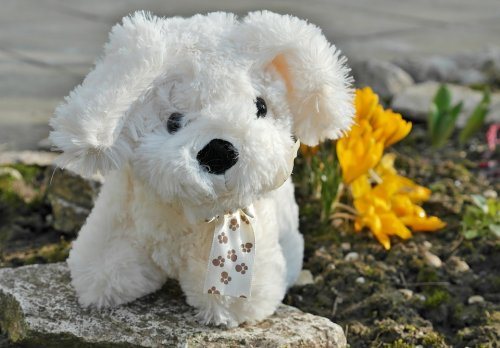
Coordination of movements
Children enjoy playing not only active games, but also calm ones - where they need to calm down and focus their attention. There is such a game - “Do as I do.” In it, the teacher performs certain movements with his arms, hands and fingers to the music, and the children repeat in unison. Choose an interesting musical accompaniment, and you will have great finger gymnastics. 3 years is the age that can be called romantic. Children really like the images of animals, butterflies, wizards, rain, breeze, etc. Kids with great pleasure participate in games where their favorite characters are mentioned. They especially love play activities about the zoo. You need to put all the kids in a circle and say “We went to the zoo and saw...”, then think about it yourself. Getting involved in the gameplay, kids are happy to repeat all the movements after the teacher, using both hands.
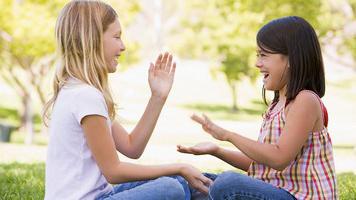
There is a game that can safely be classified as “finger gymnastics”; many children in kindergarten know it well. It's called "Stroke Pussy." The player strokes his friend’s hand with the words “Kitty, kitty, kitty...”. He can repeat this movement as much as he wishes. And suddenly you suddenly need to slap your palm with the words “Shoot.” Such exercises well develop dexterity, coordination and speed of reaction.
How to Play Finger Games for Kids
Some experts advise doing finger exercises from 6-7 months. But even at a later age, classes will be very useful and effective. You can start with a daily massage of your hands and fingers for 2-3 minutes:
- stroke and rub your palms up and down;
- knead and rub each finger lengthwise, then across;
- rub your fingers in spiral movements.
- At first, all exercises are performed slowly. Make sure that the child correctly reproduces and maintains the position of the hand or fingers and correctly switches from one movement to another. If necessary, help your baby or teach him to help himself with his other hand.
- Exercises are practiced first with one hand, unless the participation of both hands is provided. Then - with the other hand. After that - two at the same time.
- First, show your child a color drawing and explain how the exercise should be performed. Gradually, the need for explanations disappears: you show a picture, name the exercise, and the baby remembers what position of the hands or fingers he should reproduce.
We learn rhymes by playing
Children in kindergarten learn poems for performances at matinees. The classes “Finger gymnastics for 4 years old” actively help children remember them. If a child is learning a poem for his mother on March 8 in kindergarten, then for better perception and memorization the teacher can work out with him certain movements for each line.
For example:
While pronouncing the first two lines, you need to clap, pressing your palms together and changing their location. Right palm down, then up.
I bake, bake, bake,
The kids all have a pie.
After clapping, open your palms, pointing to your mother.
And for dear mother,
Clap with straight palms: first over the right shoulder, then over the left.
I'll bake two gingerbread cookies.
Rub your palms together.
Eat, eat mommy,
Sweet two gingerbread cookies.
When learning words with your child, you should show him how to read correctly, and then pronounce the words with him. Already the fourth or fifth time, the baby will remember the lines and movements and will do everything independently. Finger gymnastics in verse activates the child’s memory, has a positive effect on the development of children’s speech, and quickly switches the child’s attention, distracting him from extraneous things.
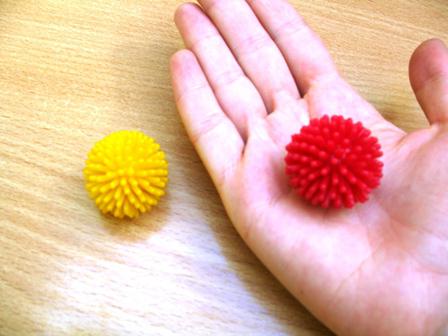
Organization and conduct of finger gymnastics
In the older group, special attention is paid to exercises to develop coordination of movements by rolling a massage ball or beating rhythms with fingers on a hard surface. As for the content side, as has already been said, the plot of the assignment should coincide with the topic of the lesson in which gymnastics is carried out. Usually it takes about 2 weeks to practice one technique. Therefore, on average, children are introduced to 2-3 new exercises per month.
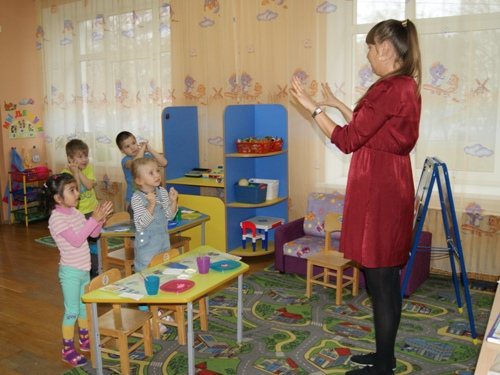
It usually takes about 2 weeks to practice and memorize one exercise.
Table: card index of finger gymnastics exercises by topic
| Subject | Exercise name | Exercise |
| "Mushrooms" | “A crow walked across the field...” | A crow walked across the field (children “walk” with the middle and index fingers of both hands on the table), carried six mushrooms in the hem (show 6 fingers): Russula, boletus (children show their fingers for each name of the mushroom, starting with the little finger), Pod-axis -no-vik, Milk mushroom, honey fungus, Champignon (show the index finger on the right hand), Who hasn’t seen it - Get out (they rhythmically hit the table with their palms, then with their fists)! |
| “The children went to the mushroom forest” | The children went into the mushroom forest (“walk” with the index and middle fingers of both hands on the table) and found mushrooms there. Some of them were then boiled, salted, dried, frozen a little and fried with potatoes (they bend or straighten their fingers, telling what they did with the mushrooms). | |
| "Basket with mushrooms" | I’m taking the basket to the forest, I’ll pick mushrooms there. My friend is surprised: “How many mushrooms are there around here” (they show surprise by spreading their arms to the sides). Boletus, butterfly, boletus, honey fungus, boletus, chanterelle, milk mushroom - Let them not play hide and seek! Saffron milk caps, little waves I'll find them at the edge of the forest. I’m returning home, take all the mushrooms with me (bend the fingers on both hands one by one, starting with the little finger of the right hand). I won’t carry the fly agaric, let it stay in the forest (they put away the thumb of the left hand and threaten it)! | |
| "Edible mushrooms" | We collected edible mushrooms for a long time, and then we told our friends this (children, naming mushrooms, bend their fingers in turn): A boletus grew in the forest, And under an oak tree, Honey mushrooms are sitting on a stump - Very friendly guys. The boletus grew under the young aspen, the large boletus grew under the white birch. If you go into the forest with us (“walk” with their fingers on the table), you will find a lot of mushrooms (raise your hands up with unclenched fingers). | |
| "Family", "Mom" | "Moms" | There are many mothers in this world, children love them all very much (they spread their arms to the sides, then tightly clasp themselves by the shoulders)! Journalist and engineer, Cook, policeman, Seamstress, conductor and teacher, Doctor, hairdresser and builder (they bend their fingers one by one, starting with the little finger, first on one hand, then on the other hand) - Different mothers are needed (they squeeze both palms into a “lock”) , Different mothers are important (spread their arms, raise their palms up)! |
| "Mom's Helpers" | One, two, three, four (alternately rhythmically hitting fist on fist and clapping their hands), We washed the dishes (one palm slides over the other): Teapot, cup, ladle, spoon And a large ladle (bend fingers, one for each name of the cookware). We washed the dishes, We just broke the cup, The ladle also fell apart, The nose of the teapot was broken. We broke the spoon a little (bend our fingers) while we helped mom. | |
| “Who has arrived?” | Who has arrived (fingers of both hands clasped together)? We, we, we (quickly clap with thumb tips)! Mom, mom, is that you (clap the tips of the index fingers)? Yes, yes, yes (clap with thumb tips)! Dad, dad, is that you (clap the ends of the middle ones)? Yes, yes, yes (clap with thumb tips)! Brother, brother, is that you (clap the tips of the nameless ones)? Yes, yes, yes (clap with thumb tips)! Oh, little sister, is that you (clap the tips of the little fingers)? Yes, yes, yes (clap with thumb tips)! We are all together, yes, yes, yes (clap hands)! | |
| "Wild animals" | "Who lives where" | Children bend their fingers - one for each couplet. A fox in a deep forest has a hole - a safe home. Winter snowstorms are not scary for a squirrel in a hollow in a spruce tree. Under the bushes a prickly hedgehog rakes leaves into a heap. Beavers make huts from branches, roots, and bark. A clubfoot sleeps in a den, He sucks his paw until spring. Everyone has their own home, everyone is warm and comfortable in it. For the last two lines, they alternately clap their hands and then hit their fists against each other. |
| "Squirrel" | A playful squirrel is jumping (“running” with its fingers on the table), tearing pine cones from pine branches (they alternately clench their fists on their right and left hands). He deftly squeezes it with his paws (they clench the fists on his right and left hands at the same time) and carries it to his closet (“running” his fingers across the table). | |
| "Hungry Mouse" | The mouse ate cheese and crumpet, pumpkin, fish, melon, pine cone, ate plums and pancakes, and dried mushrooms (they bend their fingers one by one, listing everything that the mouse ate). She chewed all day long, But everything was not enough for the mouse (they shrug)! | |
| "Fox" | Fox, little fox, beauty, Everyone likes her very much (rubs hands). The tail is fluffy, the fur is golden (spread the fingers, turn and stroke them). He wanders importantly through the forest (“walking” with his fingers on the table), instills fear in the hares (they bang their fists on the table). | |
| Winter | "Snowman" | One, two, three, four, you and I made a snowball. Round, strong, very smooth and not at all sweet. Once - we'll throw it up. Two - we'll catch it. Three - we'll drop it. And... we'll break it. One, two, three, four, five, We went for a walk in the yard. We made a snow woman, fed the birds crumbs, then we rode down the hill, and also rolled around in the snow. Everyone came home covered in snow. We ate soup and went to bed. |
| "Snowball" | We made a snowball (clasp hands), put a hat on it (hands “roof” over head), attached a nose, and instantly (twist the fist near the nose) It turned out to be a snowman (describe circles in the air)! | |
| "Christmas tree" | We had fun at the Christmas tree (rhythmically clap our hands) and danced and frolicked (rhythmic fist bumps). Afterwards, the kind Santa Claus presented us with gifts (“they walk” with the middle and index fingers of both hands on the table), He gave us huge bags, and they contained delicious items (“they walk” with the middle and index fingers of both hands on the table). Candies in blue pieces of paper, Nuts next to them, Pear, apple, one Golden tangerine (bend the fingers on both hands, starting with the thumb). | |
| "Forest" | "Trees" | Everyone in the forest is surprised (rubs their palms against each other) Different trees grow (open their palms and spread their fingers): The whole resinous pine tree has reached the sky (connect elbows - “trunk”, open palms - “crown”). The White-trunk birch has spread out its braided branches (“lanterns” moving from top to bottom). Like a blade of grass in a pole, the aspen grows thin (show the index finger, the rest are clenched into a fist). The oak tree has spread its branches, And the wind is not afraid of it (they stretch their arms up, spread their fingers). The linden blossomed (they gather their fingers into a pinch - “bud”), invited the bees to visit (they make circular rotations with the index finger - the bees fly). The spruce tree has fluffed up its needles (they lower their arms down to the sides, spread their fingers) and covered all the mushrooms (show the mushroom: the index finger is the stem, the palm on top is the cap). The leaves of the trees are rustling (they rub their palms against each other - “rustling”), as if they are having a conversation (they shake off their palms), their branches are spread out, they are waiting for the birds to visit them (they clasp their thumbs, spread their palms to the sides - show the birds). |
| "Leaves" | Autumn leaves were scattered (they make wave-like movements with their palms), I decorated them with a brush (they make smooth strokes with their palms up and down). We will go to the autumn park (“they walk” with the fingers of both hands), we will collect leaves into bouquets (they cross their palms with their fingers spread). A maple leaf, an aspen leaf (they bend their fingers one by one, starting with the thumb, on both hands at the same time to the name of each leaf), an oak leaf, a rowan leaf, a red poplar leaf and jumped down onto the path (they clap loudly in their palms). | |
| "Fruits, berries" | "Berries" | One, two, three, four, five (fingers of both hands say hello, starting with the thumb), We go for a walk in the forest (both hands walk on the table), For blueberries, For raspberries, For lingonberries, For viburnum. We will find strawberries (they bend their fingers, starting with the thumb) And we will take them to our brother. |
| "Fruits" | The connection of the fingers, between which there is a ball, starting with the little fingers; children connect one pair of fingers for each line of poetry, while their palms should not touch each other. We went to the market (little fingers connected), There were a lot of pears and persimmons (ring fingers connected), There were lemons, oranges (middle fingers connected), Melons, plums, tangerines (index fingers connected), But we bought a watermelon (thumbs connected) - This is the most delicious load (fingers clenched into a fist, thumb pulled up). | |
| "Where did the bread come from" | "Bread" | Bagel (thumb and index fingers form a circle), Bagel (thumb and middle fingers form a circle), Loaf (thumb and ring fingers form a circle) And a loaf (thumb and little finger form a circle) The baker baked the dough early in the morning (imitation of making bread). |
| "Flowers" | "They planted a seed" | They planted a grain in the ground (put a “grain” in the child’s palm), and the sun appeared in the sky. Shine, sunshine, shine (they squeeze their hands and unclench them in turn)! Grow, seed, grow (put your palms together and raise your arms up)! Leaves appear on the stem (they connect the palms, connect the fingers one by one with the thumb, on both hands at the same time), flowers bloom on the stem (they squeeze the hands and unclench them in turn). |
| "Furniture" | "Closet" | They bought me a roomy, large wardrobe for my clothes (they show how big the wardrobe is). It is beautiful and comfortable and is called “clothes”. I will put clothes in it: T-shirts, shorts and panties, Trousers, jackets and shirts (bend the fingers on both hands), Sweaters and jackets, And socks with T-shirts I will put them on the shelves. |
| "Count down from 10 to 1" | “I bought a lamb bagel” | Early in the morning (place the palm on the edge) Nakupil (show the palm) Ram (fist) Baranok (rib) For lambs (fingers of the left hand “play”), For sheep (fingers of the right hand “play”) Ten poppy rings (show 10 fingers), Nine sushi, Eight buns, Seven flatbreads, Six cheesecakes, Five cakes, Four donuts, Three cakes, Two gingerbreads And I bought one roll (show the corresponding number of fingers). I didn’t forget about myself (negative head movement), and for my wife - sunflowers (fingers of both hands spread out, thumbs pressed together). |
| "Friendship" | "Kindergarten" | In our group, everyone is friends (rhythmically banging their fists on the table). The youngest is me. This is Masha, This is Sasha, This is Yura, This is Dasha (unclench their fists, starting with the little finger). |
| "Health" | "Fingers are sleeping" | This finger wants to sleep (the thumb is bent), This finger went to bed (the index finger is bent), This finger took a little nap (the middle finger is bent), This finger is already asleep (the ring finger is bent), This one is fast asleep (the little finger is bent). Hush, hush, don’t make noise... (they shake a finger), The red sun will rise, The clear morning will come, The birds will chirp, The fingers will rise (they extend the fist from the thumb)! |
| "Water" | "Washing our hands" | Ay, water, water, water! We will always be clean (they rub their palms rhythmically, imitating washing their hands)! Splash to the right, splash to the left! Our body became wet (the fingers are clenched into a fist, then the fingers are straightened with force, as if shaking off the water)! Using a fluffy towel, dry your hands very quickly (vigorous movements imitate alternately wiping your hands with a towel). |
| "Body parts" | “In the morning my fingers woke up” | In the morning, the fingers woke up (unclench their fists), stretched (strained, spread their fingers) and shook themselves (shake their hands), hugged tightly (imitation of a handshake), got to work (“roll up their sleeves”), made Easter cakes (palms “make” pies) , They began to invite guests over (inviting movements with their hands), They started playing the piano (they imitate playing the keys) And they danced all day (the hands “dance”). |
Video: help for parents, or 10 simplest finger games
How to motivate with visibility
One of the most effective ways to attract the attention of children to a particular type of activity is to influence their visual channel of perception. For finger gymnastics you can use:
- pictures (in which children perform a specific exercise or depict the plot of a rhyme);
- video sequence (the same pictures, but combined into a video for 1–2 minutes);
- toys that perform gymnastics tasks (the teacher, at the stage of familiarization with the exercise, shows all the movements on the toy);
- personal example (the teacher completes all tasks together with the children).
Finger gymnastics
We left out a very interesting age. We are talking about two year olds. Finger gymnastics for 2 years old involves intensive work with fine motor skills of the hands. At this time, the child begins to clap his hands and react violently to the words “The horned goat has come,” tries to sculpt and draw, cut out, glue, play with cubes, and assemble a mosaic. He is learning to use his hands, plays age-related games, loves to throw a ball and bump it into something, and also knows how to open and close markers and jar lids. And for more confident and coordinated movements, the little one needs to be given the opportunity to perform actions on his own that direct him to overcome obstacles.
You teach your baby to tie shoelaces, fasten sandals, and untie knots. So that your child can better understand how to perform the action, show, sentence, and let the child repeat all the actions after you:
We take one lace,
Take the second lace.
One is above, the other is below,
Let's tie a knot.
There is another useful game “Fisherman and the Fishes” (by the way, it is sold in every store). Pour water into a basin, drop plastic sea creatures into it and, using a fishing rod with a magnet at the end, your child should catch the toys. This play activity promotes the development of fine motor skills, plus the fishing rod massages the baby’s palm, affecting the nerve endings.
Finger gymnastics for children 1-2 years old
In addition to developing fine motor skills of the hands, finger gymnastics in verse will give the child a sense of rhythm, expand his vocabulary and help him “talk” faster.
On a visit
On a visit to the big finger (the thumb is bent, the rest are clenched into a fist) They came straight to the house: Index and middle, (in accordance with the text, straighten the fingers alternately) Ring and last. The little little finger himself knocked on the threshold. Together, fingers are friends, (clench your fingers into a fist and unclench them) They can’t live without each other.
Our family
(Extend your fingers one at a time, starting with the thumb) This big finger is daddy dear. Next to dad is our mother. Next to my mother is my eldest brother. Following him is his sister - Sweet girl. And the smallest strong one - This is our glorious baby.
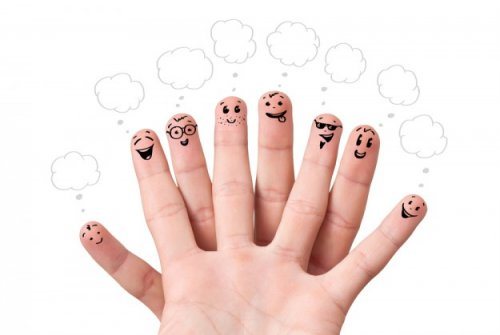
Sweet dreams, fingers!
This finger wants to sleep, This finger went to bed, This finger took a little nap, This finger is already asleep, This finger is fast asleep, Nobody makes any noise anymore. (Take the child’s palm in your hand and bend your fingers one by one, starting with the little finger.)
An owl was flying
An owl was flying, (Waving our arms) Cheerful head. She flew and flew and sat on her head. (We put our hands on our heads) She sat down, sat, turned her head, and flew off again. (We wave our hands again)
Bunny found a book
The bunny found the book, and opened it, and read it, but closed it and forgot everything. And he opened it again, And repeated everything, And closed it, and forgot again. (The palms are pressed against each other, the fingers are positioned horizontally. On the word “opened,” the palms are open, the little fingers are pressed against each other. On the word “closed,” the palms are pressed against each other.)
Finger boy
(Squeeze each of the baby’s fingers, as if addressing him: from the index finger to the little finger.)
- Finger-boy, where have you been? “I went into the forest with this brother.” “I cooked cabbage soup with this brother.” “I sang songs with this brother.” - With this, I blew the trumpet.
Make a list of gaming activities
For kindergarten teachers and primary school teachers, it is very important to have a list of games used when preparing for the next lesson. To do this, you need a systematized card index of finger gymnastics, in which the main elements of game moments, distributed according to lexical topics, should be clearly stated. The list of classes includes game titles, set goals, brief descriptions, and tasks developed in accordance with Federal State Requirements (FGT) for educational areas. And the thematic documentation is designed so that teachers of preschool and primary school education can easily navigate it while filling out their cards.
Finger gymnastics is not only fun for a child, but also a great support for an adult. It helps the child develop good coordination of movements, intensify the development of speech skills, stimulate memory, and concentrate attention. In order to see specific results, you need to perform exercises for your palms and fingers with a time interval of 5 to 8 minutes.
Remember! You cannot force a child to do something he does not want, so be patient and prepare properly for the lesson.
Finger games - benefits for children
- Performing exercises and rhythmic movements with the fingers leads to excitation in the speech centers of the brain and a sharp increase in the coordinated activity of speech zones, which ultimately stimulates the development of speech.
- Finger games create a favorable emotional background, develop the ability to imitate an adult, teach them to listen attentively and understand the meaning of speech, and increase the child’s speech activity.
- The baby learns to concentrate his attention and distribute it correctly.
- If a child performs exercises, accompanying them with short poetic lines, then his speech will become clearer, rhythmic, bright, and control over the movements performed will increase.
- The child’s memory develops as he learns to remember certain hand positions and sequences of movements. The baby develops imagination and fantasy. Having mastered all the exercises, he will be able to “tell” entire stories with his hands.
- As a result of mastering the exercises, the hands and fingers will gain strength, good mobility and flexibility, and this will make it easier to master the skill of writing in the future.
Do you use finger games for children? At what age are they interested?
